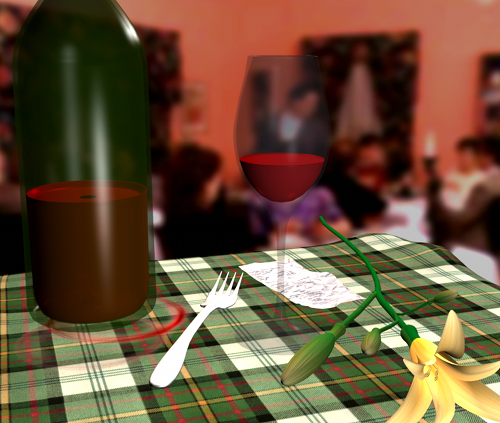The Render Manager > mental ray (Global Renderer)
The Render Manager > (expand a pass) > mental ray
Set the current pass and choose Render  Render
Render  Renderer Options from the Render toolbar.
Renderer Options from the Render toolbar.
Tab: Rendering [Properties Reference]
Set the Type option to the desired rendering algorithm. The mental ray renderer allows you to choose between three rendering algorithms : Scanline, Raytracing, and the Rasterizer.
Scanline rendering is a rendering method used to determine primary visible surfaces. Scene objects are projected onto a 2D viewing plane, and sorted according to their X and Y coordinates. The image is then rendered point-by-point and scanline-by-scanline, rather than object-by-object. Scanline rendering is faster than raytracing but does not produce as accurate results for reflections and refractions.

This scene was rendered using the scanline rendering method. Notice how the transparency has little to no depth, and there are no reflections or refractions.
If you are using the scanline algorithm, you may also have to adjust some of the Render Type settings.
Raytracing calculates the light rays that are reflected, refracted, and obstructed by surfaces. Raytracing produces realistic and precise results, but it can be time–consuming.
In raytracing, each refraction or reflection of a light ray creates a new branch of that ray when it bounces off a solid object and is cast in another direction. The various branches of rays in a scene constitute a ray tree. Each new branch can be thought of as a layer: if you add together the total number of a ray's layers, it represents the depth of that ray.

This scene was rendered using the raytracing render method. Notice how the glass reflections, transparencies, and refractions are much more realistic than with Scanline rendering.
If you are using the raytracing algorithm, you may also have to adjust some of the Render Type settings.
The Rasterizer accelerates motion blur rendering in large and complex scenes with a lot of motion blur. Using this algorithm requires that you set additional parameters that are described in The Rasterizer [Cameras and Motion Blur].
 Except where otherwise noted, this work is licensed under a Creative Commons Attribution-NonCommercial-ShareAlike 3.0 Unported License
Except where otherwise noted, this work is licensed under a Creative Commons Attribution-NonCommercial-ShareAlike 3.0 Unported License